Abstract
We conducted a detailed study using multi-source data to date the mare activity and lobate scarp formation within the Jules Verne crater on the Moon. In previous studies, the Jules Verne crater has been classified as a pre-Nectarian impact crater. Our analysis indicates that it has an absolute model age (AMA) of Ga. After its formation, a magmatic intrusion event created floor fractures, followed by two basaltic eruption events—one at 3.4 Ga and another at 2.6 Ga. Subsequently, around 1.4 billion years ago, lunar seismic activity likely took place in this region, resetting the surface ages of the crater floor fractures and surrounding areas, as evidenced by the scarp.
1. Introduction
Lobate scarps are among the youngest geologic-tectonic features on the Moon [1,2,3,4,5]. The study of lobate scarps contributes to a deeper understanding of the formation mechanisms and thermal evolution of the lunar crust. These geomorphological features reflect the structural stress and thermal processes experienced by the lunar surface throughout its geological history. Moreover, since the Moon shares certain tectonic similarities with other terrestrial planets, such as Mars, research on lobate scarps not only reveals key aspects of lunar crustal evolution but also provides valuable insights for understanding the crustal development of other terrestrial planets.
The morphology of lobate scarps is typically described as fresh, linear, or curvilinear planar features with an asymmetric profile—characterized by a steep front scarp and a gently sloping back scarp [1,2,6]. The vergence direction of the front scarp can differ from the strike of the lobate scarp [6]. Their scale is generally less than 10 km in length and tens of meters in height [2,6,7,8]. Lobate scarps can appear as a sequence of en-echelon stepping segments or as clusters of sub-scarps that are parallel or subparallel to one another [1]. A total of 3543 lobate scarps have been identified across the Moon, with most located in the lunar highlands [9]. Based on their cross-cutting relationships and morphology, lobate scarps are believed to be the surface expression of thrust faults [2,6,8,10].
Recent studies have shown that some lobate scarps are linked to shallow moonquakes.
Watters [9] found that eight near-surface moonquakes occurred within 30 km of a fault scarp. Evidence for strong seismic shaking in the vicinity of these faults is found in the degraded and missing small crater populations that extend many kilometers away from the scarps [3]. Additionally, the differences in crater degradation may also be caused by lunar seismic activity [9]. For example, Small craters in the mare basalts of the Apollo 17 Taurus–Littrow valley exhibit more advanced degradation than those in the Apollo 16 Cayley plains [9,11]. Moreover, the depth–diameter ratios of degraded craters show no systematic variation with distance from the Lee–Lincoln scarp [11]. This suggests that slip events on the Lee–Lincoln thrust fault could have caused strong seismic shaking throughout the entire Taurus–Littrow valley [9].
The main stress origin of shallow moonquakes was thought to be global contraction during lunar thermal history. From a parameterization scheme, to simulate the cooling history of the Moon, considering stress relaxation, the lithosphere is approximately treated as a linear viscoelastic body. The maximum shear stress of the lunar crust is about 200 MPa, and that of the top of the lunar mantle is about 50 MPa [12].
It can be inferred that lobate scarps are relatively young tectonic features, based on their sharp appearance, relatively small scale (commonly <10 km in length and tens of meters in height), and the craters that crosscut them (usually <50 m in diameter). Before the Lunar Reconnaissance Orbiter (LRO) mission, the first dating results were obtained from the Apollo Panoramic Camera images by Binder and Gunga [1]. The age of the scarps was determined using two types of craters: the maximum age of a scarp was estimated from the ages of craters partially overrun or cut by the fault, while the minimum age was determined from craters located on the scarp face, where slumping and landsliding caused by fault movement would destroy older craters each time it was active [1]. The crater ages were calculated following the Trask method [13], using calibration data from Moore et al. [14]. The results indicated that a total of 71 scarps are the youngest endogenic features on the Moon, with ages ranging from 60 ± 30 to 680 ± 250 million years [1]. The majority of the sub-scarps within scarp complexes were likely formed at the same time, although some sub-scarps have distinctly different ages, suggesting that some scarp complexes developed over long periods [1].
The refined crater size–frequency distribution (CSFD) analysis by van der Bogert et al. [3] demonstrated that seismic activity associated with lobate scarps effectively renew the surface both at the scarps and in adjacent areas by examining the CSFDs of five of the scarps investigated by Binder and Gunga [1] and confirming the young ages they determined. Senthil Kumar [4] also identified two scarps linked to boulder falls, where several boulders rolled and bounced down nearby slopes, indicating dynamic geological processes. Mishra and Senthil Kumar [15] investigated the temporal and spatial distribution of lobate scarps in the southern lunar polar region, finding that individual scarp segments ranged in age from 2.8 Ma to 110 Ma, with an average age of 22.5 ± 1.6 Ma. Notably, most segments (N = 130) were younger than 50 Ma, and 46 segments had ages concentrated around 10 Ma. Clark et al. [5], applying the methodology established by van der Bogert et al. [3], concluded that thrust fault scarps have been active over the past 400 Ma, with some events occurring as recently as 24 Ma. Sites located 3–4 km from the scarp traces showed comparatively older ages and greater uncertainties than those closer to the scarps, likely due to decreasing and heterogeneous seismic shaking further from the fault traces.
The Jules Verne crater is located on the far side of the Moon, with a diameter of approximately 145 km and centered at 34.9°S, 147.3°E (Figure 1a). The crater diameter to depth ratio is quite shallow, and the floor of the crater is extensively filled with mare basalt (Figure 1b). The crater rim has been heavily modified by subsequent impacts, making the original walls nearly unrecognizable (Figure 1a). The crater age is believed to be relatively old, and previous studies have shown it can be of pre-Nectarian [16] or Nectarian age [17]. A prominent large-scale linear structure exists inside the impact crater. The previous study suggests that this structure could be a graben [16]. However, parts of the graben have been interpreted as the largest isolated lunar lobate scarp [9].
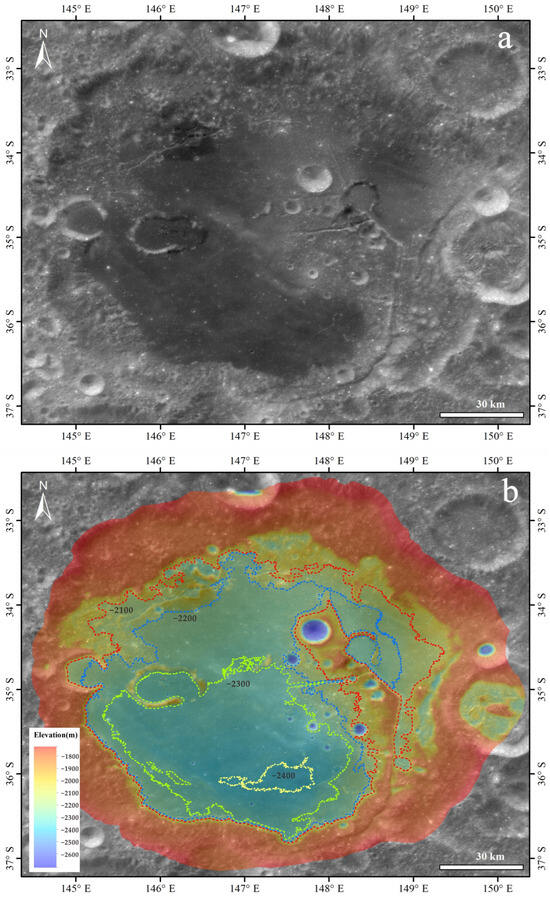
Figure 1.
(a) Location of the Jules Verne crater on a Kaguya Terrain Camera (TC) Mosaic; (b) elevation map of Jules Verne crater and contour lines within the crater floor generated by Kaguya Digital Terrain Model (DTM). Yellow dashed line, green dashed line, blue dashed line, and red dashed line represent elevations of −2400 m, −2300 m, −2200 m, and −2100 m, respectively.
Building on previous studies, we found that past dating efforts have primarily focused on smaller lobate scarps, while research on larger, isolated lobate scarps has been relatively limited. However, from a tectonic evolution perspective, large, isolated lobate scarps are likely the result of multiple geological evolutionary phases in the region. In this study, we aimed to date the largest isolated lobate scarp in Watters’ Scarp Database and analyze its evolutionary history.
2. Materials and Methods
2.1. Data
High image resolutions (higher than 10 m/pixel), as well as the solar azimuth and incidence angles, are crucial for the study of lobate scarps. The Lunar Reconnaissance Orbiter Camera (LROC) Narrow Angle Camera (NAC) images with 0.5–2 m/pixel resolution [18] and Kaguya Terrain Camera (TC) Mosaics with ~7 m/pixel [19] are used for detailed study of the lobate scarp in the Jules Verne crater (Figure 1a), as well as for the mapping and measurement of the dating craters. The Integrated Software for Imagers and Spectrometers (ISIS 7.2.0) software package is used for processing the raw LROC NAC images [20]. The processed NAC images were initially categorized into two groups based on whether the solar azimuth angle corresponds to eastward or westward illumination. Subsequently, each of these two groups was further subdivided into four groups based on the solar incidence angle: low (0°~40°), moderate (40°~55°), high (55°~80°), and very high (>80°). This results in a total of eight groups, allowing for a more refined analysis of surface features under varying lighting conditions. The results of NAC image processing are presented in Appendix A.
For larger dating regions, where NAC mosaics within a single incidence angle range are insufficient to provide complete coverage, we utilized multiple NAC mosaics with varying incidence angles for CSFD measurements, with a primary focus on those within the 55–80° incidence angle range. For smaller dating regions, we predominantly relied on NAC images within this range. For relatively flat dating regions, NAC images with incidence angles over 80° can be utilized. However, in areas near steep escarpments, significant slope variations are often present. When using NAC images with incidence angles exceeding 80°, shadows cast by steep peaks frequently obscure the relatively flat areas, making these images less suitable for CSFD measurements.
The analysis of terrain slope data is conducted using the altimetric data from the Kaguya TC stereogrammetry digital terrain model (DTM) (10 m pixel size and ~3 to 4 m altimetric accuracy) [21,22,23].
TiO2 data were derived from the Lunar Reconnaissance Orbiter Wide Angle Camera Ultraviolet/Visible (LRO WAC UV/VIS) reflectance, with a spatial resolution of approximately 400 m/pixel [24]. The FeO, Al2O3, and CaO abundance data were sourced from the Kaguya Multiband Imager (MI) dataset, which provides a higher spatial resolution of about 60 m/pixel [25,26,27].
2.2. Method
In addition to sample-based isotopic dating, CSFD measurement is an essential technique for determining the surface ages of celestial bodies where physical samples are lacking, such as Mars, the Moon, or distant asteroids. After the LRO mission, the methods of CSFD measurement and Buffered Crater Counting (BCC) measurement were refined to determine absolute model ages (AMAs) for lobate scarps.
To derive the absolute age of a lobate scarp, it is first necessary to select an optimal count area for measuring the CSFDs, which requires a homogeneous region with gentle slopes, because steep slopes can accelerate crater degradation through gravity-driven mass wasting, potentially altering the apparent age of the surface [28,29]. The selected area should also be free of obvious secondary craters, such as crater clusters and crater chains, and should represent a single geological unit, determined through compositional and morphological analysis [30]. The CSFD measurements typically identify four dating areas: distal hanging wall (HWD), proximal hanging wall (HWP), proximal footwall (FWP), and distal footwall (FWD) [3,5]. In contrast, the BCC method usually selects the scarp face or the antiformal lobes as the dating area [4,15].
The crater diameter–frequency relationships for these two dating methods are presented in cumulative form, fitting the observed CSFD of the dating area to a known crater production function [3,4,5,15]. Both Poisson timing analysis and cumulative fit techniques are employed [3,5].
In regions affected by multiple resurfacing events, analyzing the crater diameter–frequency distribution (CSFD) in differential form reveals a characteristic “kink”. This kink signifies where resurfacing processes erased smaller craters and effectively reset the crater chronometer [31]. Following such an event, the CSFD reflects crater accumulation according to the production function of the younger surface. Each segment of the CSFD that aligns with the production function can be used to determine an AMA [31]. When other resurfacing sources, such as ejecta deposits, are excluded, the AMA derived from the scarp or its surrounding areas likely corresponds to the timing of the fault movement [3].
The primary impact crater diameter measurements within the selected unit are accomplished with CraterTools 2.1 in ArcGIS [32,33,34]. We further analyzed the data using OpenCraterTool in QGIS, which enabled us to obtain the area and perimeter information of the dating region [35]. This facilitated additional analysis of the impact crater CSFD using buffered Poisson timing analysis [36]. The exported CSFDs are then plotted in differential form using pseudo-log binning in Craterstats 2.0. The production function and chronology function of Neukum (1983) [30] were used, permitting the fitting of craters as small as 10 m in diameter and up to 100 km wide.
To define the impact crater diameter range least affected by secondary cratering, a randomness analysis of the CSFD is used [31]. In this study, we utilized the mean 2nd-closest neighbor distance (M2CND) measure and the standard deviation of adjacent area (SDAA) measure to characterize the spatial distribution of craters within different diameter bins in the dating region. By comparing the actual crater distribution to the random distribution generated through Monte Carlo simulations, we can assess whether the observed crater distribution deviates from the simulated random model.
To ensure the robustness of the statistical results, a sufficient number of simulation iterations is required. If only 100 simulations are performed, the minimum resolvable p-value is 0.01, which limits the precision of statistical significance assessments. In contrast, using 3000 iterations improves the resolution to approximately 0.0003, allowing for more accurate evaluations.
This approach provides deeper insights into the post-formation modifications of the studied units, allowing for more accurate differentiation between crater sizes resulting from the initial accumulation and those formed in resurfaced areas due to later modification events. The summary plot for both the M2CND and SDAA randomness analyses for regions with crater clusters in different dating areas is displayed in the upper section of the dating result plot, with the values shown in standard deviations above or below the Monte Carlo-derived mean.
In some complex dating areas, the number of craters available for CSFD measurement is very limited, making it difficult to obtain a reliable AMA using conventional methods. Therefore, Poisson timing analysis is the only viable approach, which uses Poisson statistics and Bayesian inference to accurately exact evaluation of a crater chronology model and provides a result as a likelihood function with intrinsic uncertainty [37].
3. Results
3.1. Geological Units and Structural Features in Jules Verne Crater
Using high-resolution imagery, terrain data, and remote sensing spectral analysis, we have classified the geological units on the floor of the Jules Verne impact crater. According to the mare position of the crater floor, two primary mare units have been identified: the west mare unit (Mw) and the northeast mare unit (Mne). Within these mare units, numerous structures resulting from magmatic activity, such as wrinkle ridges and rilles, were observed. Several east–west trending channels are located in the northern part of the Mw unit, and they mainly exhibit a concentric pattern, with a few displaying a radial pattern (the crater floor fracture located within the white elliptical outline). The floor of these channels is partially filled with basalt (Figure 1). These channels often have outer surfaces primarily composed of highland materials and are significantly older than the basalt that fills them. We propose that they are most likely crater floor fractures formed by magma intrusion (Figure 2). Additionally, pyroclastic deposits can be found near one crater floor fracture (Figure 2). In terms of spectral composition and albedo characteristics, these pyroclastics deposits (Figure 1) exhibit distinct geological features compared to mare units. They are relatively enriched in TiO2 and FeO compared to the mare basalts.
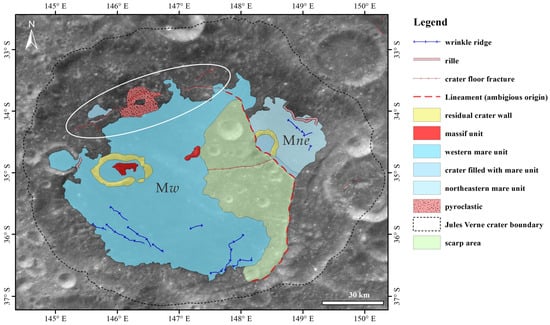
Figure 2.
Preliminary context map of the study area on Kaguya TC Mosaic with ~7 m/pixel.
A distinct linear feature, parts of which were previously interpreted as the largest isolated lunar scarp [9], is observed in the southeastern region of the impact crater from Kaguya TC Mosaic. This structure originates in the northern part of the crater floor, extending in a northwest–southeast direction (Segment ① in Figure 3a). In NAC images, we observe that this segment is connected to a nearly east–west trending floor fracture to the north. The transition trace between the lineament and the floor fracture is not very well defined (Figure 3b). There is an elevation difference of approximately 20 m, and the slope parallel to the lineament is relatively gentle. The surface shows subtle signs of creep. Towards the end of this segment, a trace appears that runs nearly parallel to the slope face (Figure 3c). The elevation of this feature is about 10 m, and the surface exhibits more pronounced creep. As the feature reaches the boundary between basalt and crater wall collapse material, its orientation shifts to a north–south direction (Segment ②). Further extending towards the wall of the Jules Verne crater, the orientation changes again, aligning northeast–southwest and running nearly parallel to the remnants of the crater wall terraces (Segment ③). Segments ② and ③, situated within the highland unit, are identified as the largest isolated lobate scarp recorded in the Watters lobate scarp database.

Figure 3.
(a) Location of different lineament segments on a Kaguya TC Mosaic. The white solid line represents Segment ①, the red solid line represents Segment ②, and the blue solid line represents Segment ③. The red square indicates the location of Figure 3b,c; (b) The connection between lineament and crater-floor fractures on NAC image mosaics with illumination from west to east and incidence angle over 80°; (c) The trace appears running nearly parallel to the slope face at the end of Segment ① on NAC image mosaic with illumination from west to east and incidence angle ranging from 55° to 80°.
At segment ②, the scarp face displays a sharp contact with the neighboring geologic unit. The elevation difference between these two units is about ~350 m and the slope of this part of the scarp face is about 20~30° (Figure 4b), the back limb scarp shows a gentle slope of less than 10° (Figure 4b), and the contact between the back scarp and the western mare unit is not clear. Towards the south, the slope becomes gentle (about 15~20°) and the sharp contact becomes indistinct; the back scarp becomes much thinner, but also steeper. Once the scarp trace changes orientation from N–E to NE–SW, the vergence direction of the scarp is uphill to the southeast. On this part of the scarp, the contact relationship between the scarp face and the adjacent geological unit becomes sharp again, but the slope of the scarp face gradually lessens, and the scarp trace terminates at a location on the crater wall. The maximum relief of this part of the scarp is about ~150 m, with the slope of the scarp face in this section being approximately 20 to 30° (Figure 4b), which is generally similar to the scarps reported earlier regarding vergence direction, maximum relief, and the maximum slope on the scarp face [7,9,38].
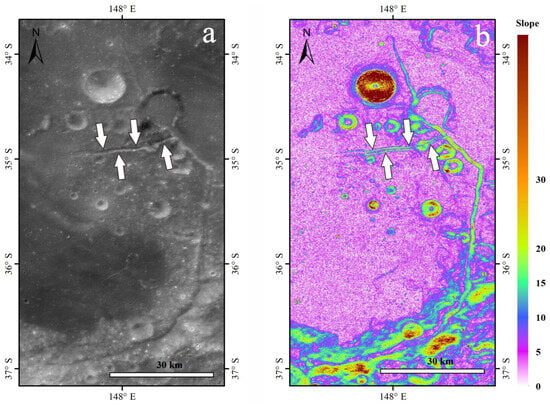
Figure 4.
The lineament in Jules Verne crater as seen in (a) a Kaguya TC Mosaic, and (b) a colorized slope map generated from Kaguya DTM.
Based on the geological features and topography of the region, we have delineated the following dating areas to analyze the geological evolution of the region (Figure 5): north lineament unit (Ln), south scarp unit (Ss), northeast mare unit (Mne), west mare unit (Mw), crater filled unit (CF), linear depression filled unit (LDF), lobate scarp south dating unit 1 (LSs1), and lobate scarp south dating unit 2 (LSs2).
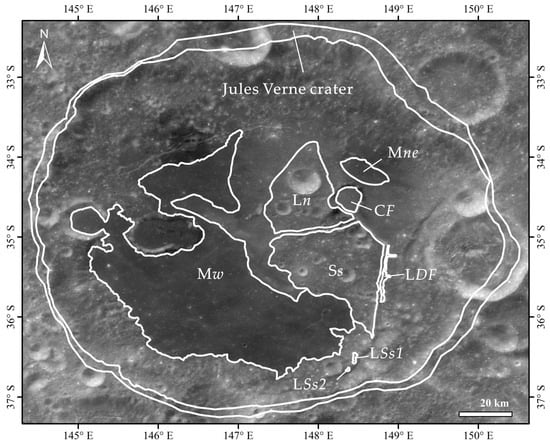
Figure 5.
Count area of all dating units on Kaguya TC mosaic; north lineament unit (Ln), south scarp unit (Ss), northeast mare unit (Mne), west mare unit (Mw), crater filled unit (CF), linear depression filled unit (LDF), lobate scarp south dating unit 1 (LSs1), lobate scarp south dating unit 2 (LSs2) and approximate path of crater rim for dating the age of the Jules Verne crater.
For the dating of the Jules Verne crater, we selected the crater rim as the count area. This decision was based on the crater’s relatively old age, which makes it nearly impossible to identify a distinct and continuous ejecta blanket. However, the rim contains a sufficient number of superposed impact craters, allowing for a more reliable age determination.
For the mare regions (Mn and Mwe), we chose areas with relatively flat terrain, which are compositionally dominated by typical mare materials—rich in TiO2 and FeO, and poor in Al2O3 and CaO—making them suitable for crater counting.
For the geological units adjacent to lobate scarps that exhibit cross-cutting relationships with the scarps (Ln, Ss, CF, LDF, LSs1, and LSs2), the materials are generally characteristic of highlands—relatively rich in Al2O3 and CaO, and poor in FeO and TiO2—and are typically located on sloped terrain. To ensure consistency and reliability in crater counting, we selected relatively flat sub-areas within these units (with slopes less than 10°) as the dating regions.
3.2. Age of Jules Verne Crater
Unfortunately, due to the extensive modification of the Jules Verne crater by subsequent impact events, it is nearly impossible to identify clear and continuous ejecta deposits, and the crater floor has been filled with later basaltic flows. Therefore, we selected the crater rim as the dating area for this study, applying the buffered crater counting technique (Figure 6a). The crater rim preserves a substantial number of superposed impact craters, making it a suitable surface for age determination. In theory, any region that was unambiguously resurfaced at the time of crater formation may be selected. For very old craters, the rim is more reliably identifiable than any ejecta blanket and, provided the crater is sufficiently large, it contains a sufficient number of superposed impact craters to support reliable age estimates. The CSFD measurements of Jules Verne crater reveal an AMA of 4.21 Ga, based on the superposing impact craters with diameters ranging from 3.8 km to 35 km (Figure 6b).
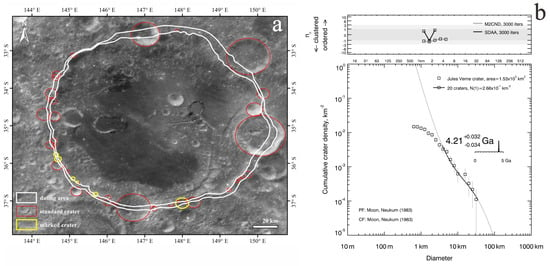
Figure 6.
(a) Dating area of Jules Verne crater rim on Kaguya TC Mosaic; (b) AMA derived from dating area.
3.3. Mare Unit
In this study, based on titanium and iron content, albedo characteristics, and elevation features, the mare within the Jules Verne crater is divided into two units. These two mare units display nearly identical geochemical properties and are both categorized as low-Ti basalts. The TiO2 content in the Mw ranges from 0.99 wt.% to 8.71 wt.% (Figure 7a) with an average of 2.70 wt.%, while in the Mne, it varies from 0.99 wt.% to 5.85 wt.% with an average of 2.90 wt.% (Figure 7a). The FeO content in the Mw spans from 5.03 wt.% to 19.67 wt.% (Figure 7b) with an average of 15.35 wt.%, whereas in the Mne, it ranges from 10.26 wt.% to 17.73 wt.% with an average of 14.22 wt.% (Figure 7b).
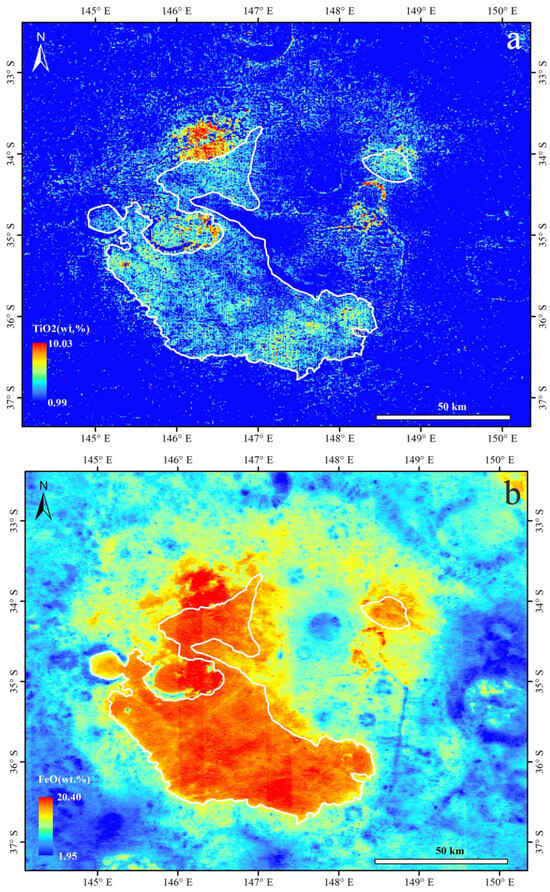
Figure 7.
(a) TiO2 abundance map derived from the WAC reflectance mosaic (~400 m/pixel) [24]. The white solid line represents the boundaries of the Mw and Mne units; (b) Kaguya MI FeO map (~60 m/pixel) [26].
CSFD analysis indicates that the Mw has an AMA of 2.67 Ga, derived from impact craters with diameters between 290 m and 1.3 km (Figure 8c). Similarly, the Mne shows an AMA of 2.86 Ga, based on craters with diameters ranging from 150 m to 1.7 km (Figure 8d).
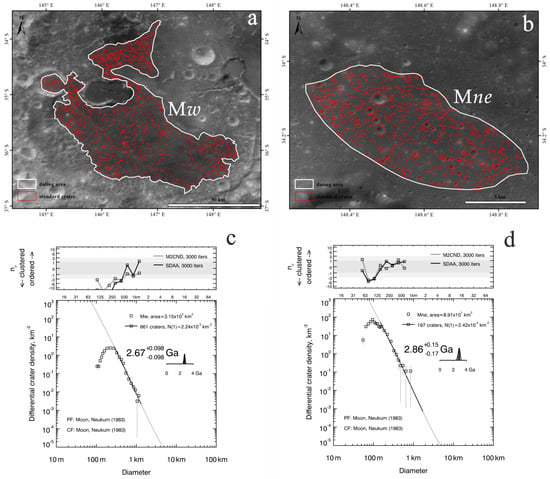
Figure 8.
(a) Count area and measured craters of the Mw unit on Kaguya TC mosaic; (b) count area and measured craters of the Mne unit on Kaguya TC mosaic; AMAs derived for the (c) Mw and (d) Mne units.
3.4. Linear Structure Affinity
Compared to the mare units within the Jules Verne crater, the area on which the linear features occur is relatively enriched in Al2O3 and CaO (Figure 9a,b), especially on the walls of younger impact craters. In the central region, there is a radial crater-floor fracture (Figure 2 and Figure 4a). The structure is generally oriented in an east–west direction and does not extend into the basalt unit to the west (white arrows in Figure 4). The eastern side has been cross-cut by the lineament. Using this structure as a boundary, we have divided the linear structure into two units: the north lineament unit (Ln) (Figure 10a) and south scarp unit (Ss) (Figure 10b).
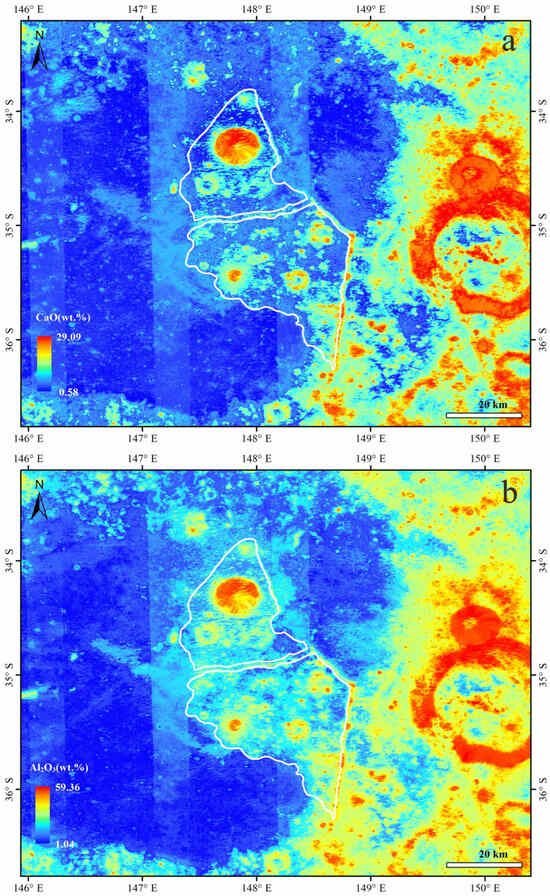
Figure 9.
(a) Kaguya MI CaO map (~400 m/pixel); (b) Kaguya MI Al2O3 map (~60 m/pixel).

Figure 10.
(a) Count area and measured craters of the Ln unit on NAC image mosaic with illumina-tion from west to east and incidence angle ranging from 0° to 80°; (b) count area and measured craters of the Ss unit on NAC image mosaic with illumination from west to east and incidence angle ranging from 0° to 80°; AMAs derived for the (c) Ln and (d) Ss units.
Lunar seismic activity can cause small impact craters near the scarp to disappear or degrade more rapidly. The seismic activity responsible for forming this lobate scarp [3,5], particularly in its back scarp area, may represent a partial resurfacing event. For both of the dating units, we use a differential plot to illustrate the relationship between the size and frequency of impact craters. The CSFD analysis indicates that both the Ln and Ss regions exhibit three distinct AMAs. For the Ln, the AMAs are 1.41 Ga, 3.29 Ga, and 3.81 Ga, derived from impact craters with diameter ranges of 260–490 m, 510–800 m, and 1.2–2.0 km (Figure 10c). Similarly, the Ss shows AMAs of 1.39 Ga, 3.27 Ga, and 3.78 Ga, based on craters with diameter ranges of 210–440 m, 420–660 m, and 930 m–2.2 km (Figure 10d).
To better understand the context of the scarp, we also dated two units in its vicinity. The linear depression fill (LDF) unit shows a sharp contact with the Ss unit (Figure 11a). The CSFD analysis reveals that the LDF unit has an AMA of 1.43 Ga, calculated based on impact craters ranging in diameter from 110 m to 330 m (Figure 11c). The crater fill (CF) unit is within a crater near the Ln which was filled with basalt (Figure 11b). The CSFD analysis indicates that the CF unit has AMAs of 1.10 Ga and 3.51 Ga, based on impact craters with diameters ranging from 98 m to 220 m and 260 m to 640 m (Figure 11d).
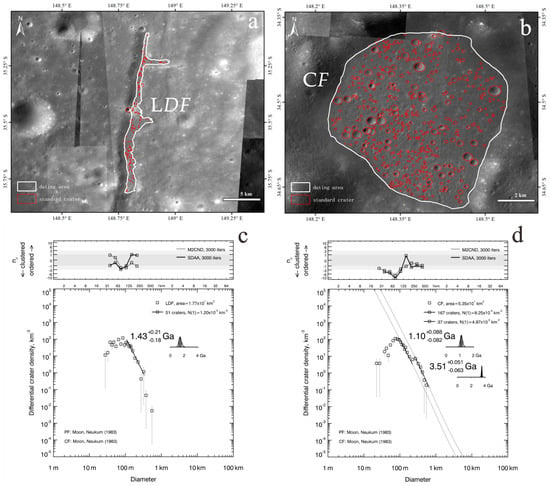
Figure 11.
(a) Count area and measured craters of the LDF unit on NAC image mosaic with illumination from west to east and incidence angle ranging from 55° to 80°; (b) count area and measured craters of the CF unit on NAC image mosaic with illumination from west to east and incidence angle ranging from 0° to 80°; AMAs derived for the (c) LDF and (d) CF units.
On the southern segment of the lobate scarp, we also identified two dating areas: lobate scarp south area 1 (LSs1) and lobate scarp south area 2 (LSs2) (Figure 12a). They are located on the gentle section of the uphill-facing scarp. The CSFD analysis indicates that the LSs1 unit has AMAs of 66 Ma and 810 Ma, calculated from impact craters with diameters between 11 m and 40 m, and 70 m and 200 m (Figure 12b). In a similar manner, the LSs2 unit has AMAs of 61.9 Ma and 650 Ma, derived from impact craters with diameters ranging from 10 m to 25 m and 38 m to 97 m (Figure 12c).
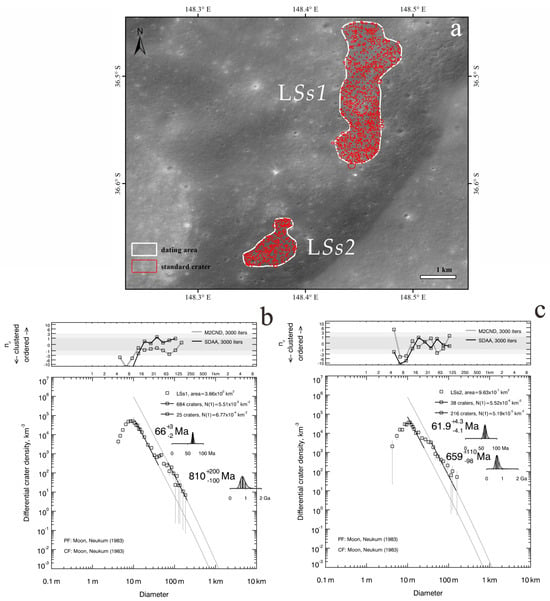
Figure 12.
(a) Count area and measured craters of LSs1 and LSs2 on Kaguya TC Mosaic; AMAs derived for the (b) LSs1 and (c) LSs2 areas.
4. Discussion
4.1. Magmatic Activity
Previous studies have shown that there are two lunar mare units within the Jules Verne crater. Yingst and Head [39] classified the mare basalt deposits on the floor of the Jules Verne crater into two distinct flows: a northeastern flow and a western flow. They identified the northeastern flow as being older but did not provide an AMA for it. Haruyama et al. [40] determined an AMA of 3.34 Ga for the mare basalts within the Jules Verne crater. Unlike Yingst and Head [39], they did not differentiate the mare basalts into two mare units. Pasckert et al. [41] identified eight lunar mare units within and around the Jules Verne crater, and they proposed that the Mne unit has an age of 3.38 Ga, while the Mw unit dates to 3.22 Ga.
Our dating results show distinctly different characteristics compared to previous studies.
When selecting dating regions, we incorporated higher-resolution spectral data. Our analysis revealed that the basalt in these regions exhibits highly similar spectral compositions, implying a shared magmatic origin and formation period. Consequently, their ages are likely comparable. Additionally, we noted that larger impact craters in this region are often concentrated near the back area of the scarp. The ejecta from these craters predominantly consists of plagioclase-rich material rather than basaltic material. This suggests that the basaltic units are younger than the units comprising the scarp area.
Pasckert et al. [41] conducted an analysis of excavation depths from the largest impact craters to determine the mare thicknesses of the Mw and Mne. They found that the thicknesses are 100 m and 81 m, and these layers cover approximately 60% of the crater floor area. There is an elevation difference of approximately 80 m between the CF unit and the Mne unit (Figure 13b), also the positive relief trace shows in Figure 3c indicating that the mare basalt represented by the Mne unit did not cover the CF unit (Figure 13a). Therefore, the CF unit represents an older basaltic activity, and its AMA is consistent with the results of Pasckert et al. However, for the Mw unit, a similar situation did not occur. We revised the dating area based on elevation and reclassified it into three regions—Mw-a, Mw-b, and Mw-c (Figure 14a–c)—according to the contour lines. These regions represent areas with elevations ranging from −2300 to −2200 m, −2400 to −2300 m, and below −2400 m (Figure 1b). We observed that the dating results indicate that units with lower elevations are relatively younger. The CSFD measurements of Mw-a reveal an AMA of 3.28 Ga, based on impact craters with diameters ranging from 320 m to 1 km (Figure 14d), which is quite close to the result of previous studies [39,41]. As for the Mw-b and Mw-c units, their ages are close to the AMA of the Mne unit (~2.86 Ga) (Figure 14e,f). We propose this is likely due to the fact that the density of the lunar basalt in the mare is greater than that of the underlying lunar crust, causing gravitational subsidence of the mare. This mechanism is also one of the causes of the lunar grabens [42,43]. We can identify a small lunar graben with a near northeast–southwest orientation on the northeastern side of the Mw-c unit (Figure 14c).
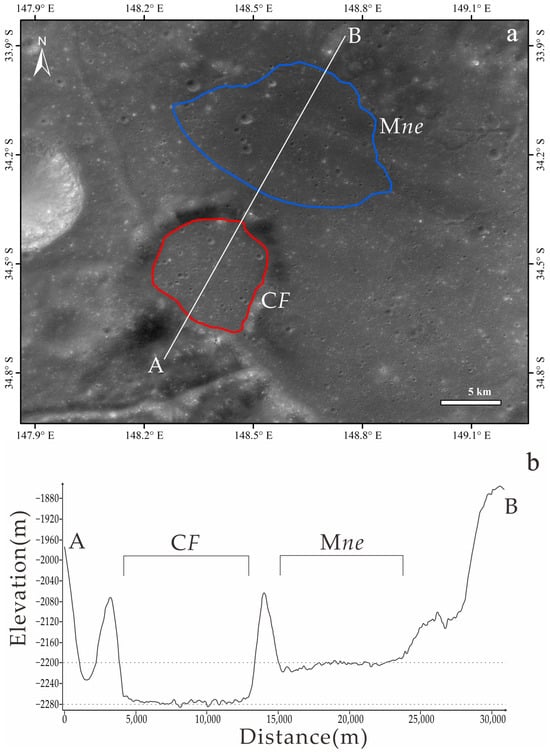
Figure 13.
(a) Dating area of CF unit and Mne unit on Kaguya TC Mosaic; (b) elevation difference between CF and Mne unit.
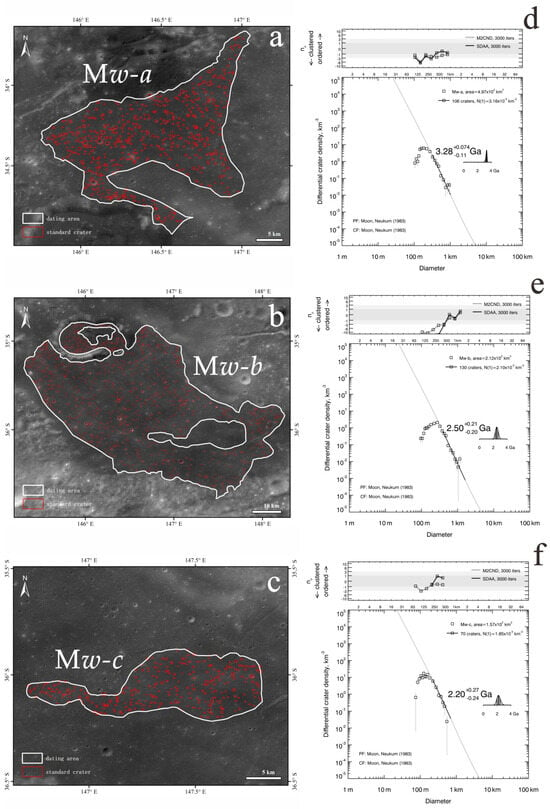
Figure 14.
(a) Count area and measured craters of Mw-a unit on Kaguya TC Mosaic; (b) count area and measured craters of Mw-b unit on Kaguya TC Mosaic; (c) count area and measured craters of Mw-c unit on Kaguya TC Mosaic; AMAs derived for the (d) Mw-a, (e) Mw-b, and (f) Mw-c units.
Large impact craters located within the mare regions often have their floors covered by basalt, but their residual crater walls tend to be richer in TiO2 and FeO compared to the surrounding basalt-covered areas and exhibit a composition similar to that of pyroclastic deposits.
The pyroclastic deposits which occur along crater-floor fractures are closely related to the formation of these fractures. The formation of crater-floor fractures is often related to the interaction between magmatic intrusion and the structure of the crater. When the dike propagates vertically towards the surface and encounters the low-density brecciated region beneath the crater, the magmatic driving pressure is insufficient to continue vertical propagation, but the pressure within the dike exceeds the local lithostatic pressure. At this point, the dike begins to propagate laterally, forming a sill. Due to the increased overburden pressure from the crater wall and rim, the dike is compressed at this boundary and cannot propagate further into the crater floor region. The sill then continues to inflate, further raising and fracturing the brittle crater floor, eventually resulting in radial, concentric, or polygonal fracture features [44]. Pyroclastic deposits are one of the obvious features to form during the subsequent cooling, evolution, and degassing of the sill or laccolithic magmatic intrusion. However, we observed that the formation of crater-floor fractures in the study area predates the eruption of lunar mare basalts, while the eruption of pyroclastic rocks occurred later than the formation of these fractures, presumably resulting from subsequent magmatic activity. The distribution areas of crater-floor fractures have relatively steep slopes (>10°), and their thickness is limited, making it impossible to obtain accurate AMAs.
The remaining crater floor areas are significantly elevated compared to the basaltic units, and their locations are distinctly different from the central peaks, indicating that the residual crater floors have undergone uplift processes. The indistinct traces associated with segment ①, along with the radial fractures present in the scarp area, suggest that the scarp area likely represents early-formed crater-floor fractures. Since the subsidence resulting from intrusion cooling will occur along the existing concentric fractures, in cases of significant subsidence, these fractures may evolve into fault or scarp morphologies [45].
4.2. Morphology and Dating Result of the Jules Verne Scarp
We interpret that the large lobate scarps developed on the crater floor most likely evolved from early-formed crater-floor fractures. Since the subsidence resulting from intrusion cooling will occur along the existing concentric fractures, substantial subsidence may lead these fractures to develop into scarp-like features [45]. However, the crater-floor fractures, due to the increased overburden pressure from the crater wall and rim, cause the dike to be compressed at this boundary, preventing further propagation into the crater floor region. This mechanism fails to explain the portion of the large linear structures that extend toward the crater wall. Lobate scarps, on the other hand, are more likely to form on surfaces with a certain degree of slope in highland materials.
Regarding the dating results for Segment ③ on the southern side (LSs1 and LSs2), we believe these cannot represent the formation age of the lobate scarp. This is because the slope in this area is relatively steep (>15°, the steepest areas can exceed 30° (Figure 3b)), and the size of the dated region, as well as the frequency and diameter of impact craters available for dating within this region, are severely limited. Strong seismic shaking near lobate scarps has been found to degrade and eliminate small crater populations, while also reducing the dating area (e.g., LSs1 and LSs2, located between two steep slopes). Clark J. D. et al. [5] defines a ΔCrater diameter value (the largest crater diameter reset by the scarp activity minus the smallest diameter affected) which varies from 20 to almost 100 ΔCrater diameter (m), the ΔCrater diameter generally shows an upward trend with increasing AMA, potentially indicating that the duration and magnitude of seismic activity have been diminishing over the past ~250 million years.
In the Ln unit, the area is dominated by a resurfacing event associated with the large crater with a diameter of approximately 9.9 km. The secondary craters caused by this impact event are likely included in our statistics of impact craters for this counting area. How ever, our CSFD measurements for Ss unit and the geological units adjacent to them (LDF unit and CF unit) (Table 1) indicate that the most recent major partial resurfacing event occurred around ~1.4 Ga. We interpret this as the latest fault movement of the Jules Verne scarp.

Table 1.
The result of the CSFD measurement.
Additionally, we found that while the crater diameter range for AMA determination is similar for the Ln and Ss units, there is a degree of sorting in the distribution of craters within this range on the Ss unit. Specifically, fewer craters in this diameter range are observed on the side closer to the scarp face, a feature not prominently observed in the Ln unit.
Furthermore, it is different from most lobate scarps, which are often associated with cross-cutting relationships with small-diameter impact craters (<50 m) [46]. The scarp face of Jules Verne scarp features a relatively large impact crater with a diameter of about 700 m (Figure 15a) and 567 m (Figure 15b). We observed that this crater exhibits east–west elongation deformation, along with evident mass movement features on the western crater wall (Figure 15). However, due to the presence of ejecta deposits, the contact boundary between the scarp face and the adjacent LDF unit has not become sharper. This suggests that impacts occurring after the formation of the scarp face tend to soften the slope rather than refresh it. We infer that the sharp contact observed in this region is most likely caused by moonquakes.
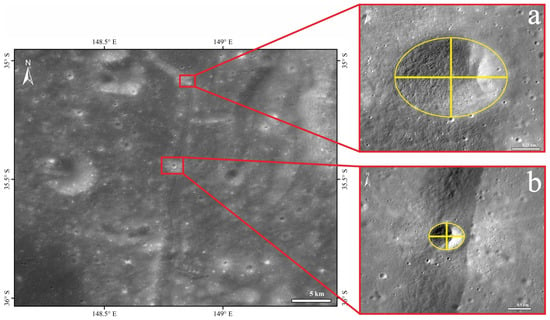
Figure 15.
The location of the deformation crater. (a) Crater with a diameter of about 700 m located in the connection of segment ① and segment ② on NAC image mosaic with illumination from west to east and incidence angle ranging from 55° to 80°; (b) crater with a diameter of 567 m on the slope face of segment ② on NAC image mosaic with illumination from west to east and incidence angle ranging from 55° to 80°.
4.3. Evolution History of Jules Verne Scarp
Based on geological dating results and the cross-cutting relationships between geological units, we infer that the formation of the Jules Verne crater is ~4.21 Ga. The ages of 3.83 Ga and 3.95 Ga obtained from the Ln and Ss units represent uplifted crater floors. These areas experienced magmatic activity at the crater bottom, which led to the formation of crater floor fractures. However, the mechanism of floor fracturing cannot be regarded as a partial resurfacing event, meaning that the ages of 3.83 Ga and 3.95 Ga do not represent the formation time of the floor fractures.
Additionally, the crater floor fracture model does not fully explain the entire structural propagation toward the crater wall (e.g., Segment ③ in Figure 3a), nor the sharp contact observed between the scarp face and the surrounding geological units. Crater floor fractures are generally confined to the crater floor and are mainly influenced by the overburden pressure exerted by the crater wall [44].
On the other hand, the age of 3.5 Ga obtained from the CF unit indicates that the formation of the floor fractures occurred prior to basaltic activity, likely between 3.51 Ga and 4.21 Ga. Around 3.4 Ga, a major lunar mare basalt eruption filled the CF unit and part of the Mw unit. Subsequently, at approximately 2.6 Ga, another basaltic eruption event covered the Mne unit and portions of the Mw unit, causing subsidence in the Mw unit. This subsidence resulted in lower-elevation areas that were likely either covered by later small flows or functioned as regolith sinks.
The most recent major tectonic activity occurred around 1.4 Ga. This event reactivated the surfaces of the previously formed floor fractures and nearby areas, altering their crater frequency–distribution characteristics. We speculate that this age may be associated with tectonic activity triggered by moonquakes.
5. Conclusions
This study discusses the magmatic and tectonic history of the Jules Verne crater, focusing on its basaltic units and the evolution of crater-floor fractures and lobate scarps. The dating results (Figure 16) reveal two main episodes of mare activity: an older one around 3.4 Ga, and a younger basaltic deposit formed around 2.6 Ga. The Mw unit showed varying ages, with lower elevations representing younger units. The analysis of crater-floor fractures suggests that these predated basaltic eruptions and were later associated with pyroclastic deposits due to magmatic activity. The formation of lobate scarps is linked to the reactivation of these fractures around 1.4 Ga, likely due to seismic processes. Overall, the geological history is marked by multiple magmatic events, subsidence, and tectonic reactivation over the course of billions of years, shaping the current morphology of the Jules Verne crater.
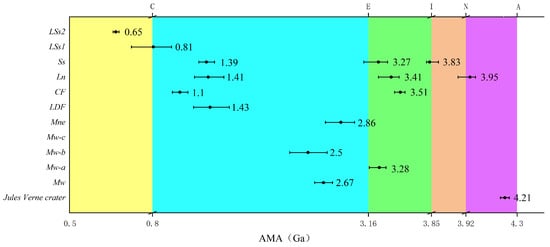
Figure 16.
Dating results of all units. The letters above the chart indicate different lunar geological periods: C stands for the Copernican period, E for the Eratosthenian period, I for the Imbrian period, N for the Nectarian period, and A for the Aitken period—A subdivision of the early Pre-Nectarian era, associated with the formation of the South Pole–Aitken basin.
Author Contributions
Conceptualization, J.L. (Jianzhong Liu), G.M., C.W., W.I. and C.H.v.d.B.; methodology, J.L. (Jianzhong Liu), G.M. and C.W.; software, G.M. and C.W.; validation, C.W., G.M. and K.Z.; formal analysis, C.W.; investigation, C.W. and J.L. (Jianzhong Liu); resources, J.L. (Jingwen Liu) and C.W.; data curation, G.M.; writing—original draft preparation, C.W.; writing—review and editing, J.L. (Jianzhong Liu), G.M., W.I. and C.H.v.d.B.; visualization, C.W.; supervision, J.L. (Jingwen Liu) and G.M.; project administration, J.L. (Jianzhong Liu), H.H., K.Z. and J.L. (Jingwen Liu); funding acquisition, J.L. (Jianzhong Liu), H.H., K.Z. and J.L. (Jingwen Liu) All authors have read and agreed to the published version of the manuscript.
Funding
This research was funded by the National Key Research and Development Program of China (Grant No. 2022YFF0503100); the National Natural Science Foundation of China (Grant No. 42202264); the Guizhou Provincial Science and Technology Projects (Grant No. QKHJC-ZK(2023)-478, No. QKHJC-ZK(2024)-670) and No. QKHZDZX-(2024)-016); the Key Research Program of the Chinese Academy of Sciences (Grant No. KGFZD-145-23-15); the Compilation of Chinese Regional Geological Chronicles and Series of Maps (Grant No. DD20221645); Guiyang University Talent Introduction Startup Fund Research Project (Grant No. GYU-KY-[2025]). This collaboration was also supported by Sino-German Center Mobility Fund M-0016 and German Space Agency Grants 50OW2001 and 50OW2402.
Data Availability Statement
Optical image data from LRO and SELENE used in this study can be downloaded from the website of the United States Geological Survey at https://astrogeology.usgs.gov/search/map/Moon/LRO/LROC_WAC/Lunar_LRO_LROC-WAC_Mosaic_global_100m_June2013 (accessed on 4 October 2023). LROC NAC images were download from the PDS Geosciences Node (https://ode.rsl.wustl.edu/Moon/indexProductSearch.aspx, accessed on 4 March 2024).
Acknowledgments
We extend our heartfelt gratitude to T.R. Watters of the Center for Earth and Planetary Studies, Smithsonian Institution, for generously sharing his lobate scarp database.
Conflicts of Interest
The authors declare no conflicts of interest.
Appendix A
| Direction of Illumination | INCIDENCE Angle (°) | Employed NAC Images | |
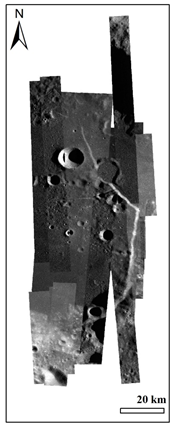 | From east to west | >80 | M1109676757RE/LE, M1170923660RE/LE, M1170916537RE/LE, M1306164047RE/LE |
| 55~80 | M1245030675RE/LE, M161332996LE/RE, M161339777RE/LE, M1245044742RE/LE, M1122622635RE/LE, M176663890RE/LE, M1122615532RE/LE, M1153239008RE/LE, M1245037709RE/LE, M1199166693RE/LE, M1137950246RE/LE, M1290914130RE/LE, M1168571349RE/LE, M1137957356RE, M1303816834RE/M1303816834LE | ||
| 40~55 | M189628783RE/LE, M143650134RE/LE, M1150882595RE/LE, M1212094957RE/LE, M1181499900RE/LE, M1166218921RE/LE, M1196817690RE/LE, M125956762RE/LE | ||
| 0~40 | M125956762LE/RE, M156617495RE/LE, M156624304LE/RE, M110622357LE/RE, M1240325648LE/RE, M1148533700RE/LE | ||
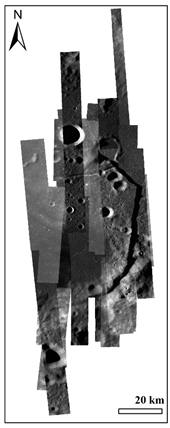 | From west to east | >80 | M1156789111RE/LE, M1126169115RE/LE, M1218007757RE/LE, M1217993691RE/LE, M180193241RE/LE |
| 55~80 | M149546857RE/LE, M1263844300LE/RE, M1324964452RE/LE, M134219181RE/LE, M1368464784RE/LE, M1279154768LE, M103539841RE/LE, M1143818386RE/LE, M1174429306RE/LE, M1220356884RE/LE, M1340269147RE/LE, M1235627737RE/LE, M182544976RE/LE, M1340276136RE/LE, M167234652RE/LE, M1250936528RE/LE | ||
| 40~55 | M136580477RE/LE, M1312075991RE/LE, M1130884072RE/LE, M1146179020RE/LE, M1100238883RE/LE, M184903825RE/LE, M1207389985RE/LE, M1357854690LE/RE | ||
| 0~40 | M1283864587RE/LE, M187269906LE, M1299113400LE/RE, M108265116LE/RE, M1344971054LE/RE, M1102603360LE/RE |
References
- Binder, A.B.; Gunga, H.-C. Young thrust-fault scarps in the highlands: Evidence for an initially totally molten moon. Icarus 1985, 63, 421–441. [Google Scholar] [CrossRef]
- Watters, T.R.; Robinson, M.S.; Beyer, R.A.; Banks, M.E.; Bell, J.F.; Pritchard, M.E.; Hiesinger, H.; van der Bogert, C.H.; Thomas, P.C.; Turtle, E.P.; et al. Evidence of Recent Thrust Faulting on the Moon Revealed by the Lunar Reconnaissance Orbiter Camera. Science 2010, 329, 936–940. [Google Scholar] [CrossRef]
- van der Bogert, C.H.; Clark, J.D.; Hiesinger, H.; Banks, M.E.; Watters, T.R.; Robinson, M.S. How old are lunar lobate scarps? 1. Seismic resetting of crater size-frequency distributions. Icarus 2018, 306, 225–242. [Google Scholar] [CrossRef]
- Kumar, P.S.; Sruthu, I.; Lakshmi, K.J.P.; Menon, R.; Amitabh Krishna, B.G.; Kring, D.A.; Head, J.W.; Goswami, J.N.; Kumar, A.S.K. Recent shallow moonquake and impact-triggered boulder falls on the Moon: New insights from the Schrödinger basin. J. Geophys. Res. Planets 2016, 121, 147–179. [Google Scholar] [CrossRef]
- Clark, J.D.; van der Bogert, C.H.; Hiesinger, H. How old are lunar lobate scarps? 2. Distribution in space and time. Earth Planet. Sci. Lett. 2024, 633, 118636. [Google Scholar] [CrossRef]
- Watters, T.R.; Schultz, R.A. Planetary Tectonics; Cambridge University Press: Cambridge, UK, 2010. [Google Scholar]
- Banks, M.E.; Watters, T.R.; Robinson, M.S.; Tornabene, L.L.; Tran, T.; Ojha, L.; Williams, N.R. Morphometric analysis of small-scale lobate scarps on the Moon using data from the Lunar Reconnaissance Orbiter. J. Geophys. Res. 2012, 117, E00H11. [Google Scholar] [CrossRef]
- Watters, T.R. Thrust faults along the dichotomy boundary in the eastern hemisphere of Mars. J. Geophys. Res. 2003, 108, 1934. [Google Scholar] [CrossRef]
- Watters, T.R.; Weber, R.C.; Collins, G.C.; Howley, I.J.; Schmerr, N.C.; Johnson, C.L. Shallow seismic activity and young thrust faults on the Moon. Nat. Geosci. 2019, 12, 411–417. [Google Scholar] [CrossRef]
- Binder, A.B. Post-imbrian global lunar tectonism: Evidence for an initially totally molten Moon. Earth Moon Planets 1982, 26, 117–133. [Google Scholar] [CrossRef]
- Mahanti, P.; Robinson, M.; Thompson, T.; Henriksen, M. Small lunar craters at the Apollo 16 and 17 landing sites—Morphology and degradation. Icarus 2018, 299, 475–501. [Google Scholar] [CrossRef]
- Tao, S.; Shi, Y.L.; Zhu, B.J. Preliminary analysis of the relationship between the thermal stress of the Moon in cooling process and moonquake mechanisms. Chin. J. Geophys. 2023, 66, 3730–3746. (In Chinese) [Google Scholar]
- Trask, N.J. Geologic Comparison of Mare Materials in the Lunar Equatorial Belt, Including Apollo 11 and Apollo 12 Landing Sites; U.S. Geological Survey: Reston, VA, USA, 1971; pp. D138–D144.
- Moore, H.J.; Boyge, J.M.; Schaber, G.G.; Sgott, D.H. Lunar Remote Sensing and Measurements, in Apollo 15–17 Orbital Investigations; Professional Paper; U.S. Geological Survey: Reston, VA, USA, 1980.
- Mishra, A.; Kumar, P.S. Spatial and Temporal Distribution of Lobate Scarps in the Lunar South Polar Region: Evidence for Latitudinal Variation of Scarp Geometry, Kinematics and Formation Ages, Neo-Tectonic Activity and Sources of Potential Seismic Risks at the Artemis Candidate Landing Regions. Geophys. Res. Lett. 2022, 49, e2022GL098505. [Google Scholar] [CrossRef]
- Fortezzo, C.; Spudis, P.; Harrel, S. Release of the digital unified global geologic map of the moon at 1:5,000,000. In Proceedings of the 51st Lunar and Planetary Science Conference, Lunar and Planetary Institute, Houston, TX, USA, 16–20 March 2020. [Google Scholar]
- Stuart-Alexander, D.E. Geologic Map of the Central Far Side of the Moon; U.S. Geological Survey: Reston, VA, USA, 1978. [CrossRef]
- Robinson, M.S.; Brylow, S.M.; Tschimmel, M.; Humm, D.; Lawrence, S.J.; Thomas, P.C.; Denevi, B.W.; Bowman-Cisneros, E.; Zerr, J.; Ravine, M.A.; et al. Lunar Reconnaissance Orbiter Camera (LROC) Instrument Overview. Space Sci. Rev. 2010, 150, 81–124. [Google Scholar] [CrossRef]
- Haruyama, J.; Ohtake, M.; Matsunaga, T.; Morota, T.; Yokota, Y.; Honda, C.; Hirata, N.; Demura, H.; Iwasaki, A.; Nakamura, R.; et al. Planned radiometrically calibrated and geometrically corrected products of lunar high-resolution Terrain Camera on SELENE. Adv. Space Res. 2008, 42, 310–316. [Google Scholar] [CrossRef]
- Anderson, J.A.; Sides, S.C.; Soltesz, D.L.; Sucharski, T.L.; Becker, K.J. Modernization of the Integrated Software for Imagers and Spectrometers. In Proceedings of the Lunar and Planetary Science Conference, League City, TX, USA, 15–19 March 2004. [Google Scholar]
- Haruyama, J.; Hara, S.; Hioki, K.; Iwasaki, A.; Morota, T.; Ohtake, M.; Matsunaga, T.; Araki, H.; Matsumoto, K.; Ishihara, Y.; et al. Lunar Global Digital Terrain Model Dataset Produced from SELENE (Kaguya) Terrain Camera Stereo Observations. In Proceedings of the 43rd Lunar and Planetary Science Conference, Woodlands, TX, USA, 19–23 March 2012. [Google Scholar]
- Barker, M.K.; Mazarico, E.M.; Neumann, G.A.; Smith, D.E.; Zuber, M.T. Merging Digital Elevation Models from the Lunar Orbiter Laser Altimeter and Kaguya Terrain Camera. In Proceedings of the 45th Lunar & Planetary Science Conference, Woodlands, TX, USA, 17–21 March 2014. [Google Scholar]
- Barker, M.; Mazarico, E.; Neumann, G.; Zuber, M.; Haruyama, J.; Smith, D. A new lunar digital elevation model from the Lunar Orbiter Laser Altimeter and SELENE Terrain Camera. Icarus 2016, 273, 346–355. [Google Scholar] [CrossRef]
- Sato, H.; Robinson, M.S.; Lawrence, S.J.; Denevi, B.W.; Hapke, B.; Jolliff, B.L.; Hiesinger, H. Lunar mare TiO2 abundances estimated from UV/Vis reflectance. Icarus 2017, 296, 216–238. [Google Scholar] [CrossRef]
- Haruyama, J.; Matsunaga, T.; Ohtake, M.; Morota, T.; Honda, C.; Yokota, Y.; Torii, M.; Ogawa, Y.; LISM Working Group. Global lunar-surface mapping experiment using the Lunar Imager/Spectrometer on SELENE. Earth Planets Space 2008, 60, 243–255. [Google Scholar] [CrossRef]
- Lemelin, M.; Lucey, P.G.; Song, E.; Taylor, G.J. Lunar central peak mineralogy and iron content using the Kaguya Multiband Imager: Reassessment of the compositional structure of the lunar crust. J. Geophys. Res. Planets 2015, 120, 869–887. [Google Scholar] [CrossRef]
- Zhang, L.; Zhang, X.; Yang, M.; Xiao, X.; Qiu, D.; Yan, J.; Xiao, L.; Huang, J. New maps of major oxides and Mg # of the lunar surface from additional geochemical data of Chang’E-5 samples and KAGUYA multiband imager data. Icarus 2023, 397, 115505. [Google Scholar] [CrossRef]
- Basilevskii, A.T. On the evolution rate of small lunar craters. In Proceedings of the Lunar and Planetary Science Conference Proceedings, Houston, TX, USA, 15–19 March 1976. [Google Scholar]
- Meyer, H.M.; Mahanti, P.; Robinson, M.S.; Boyd, A. Quantifying the Effect of Slope on Crater Density: A Preliminary Overview. In Proceedings of the 47th Lunar and Planetary Science Conference, Woodlands, TX, USA, 21–25 March 2016. [Google Scholar]
- Neukum, G. Meteorite Bombardment and Dating of Planetary Surfaces; Ludwig-Maximilians University: Munich, Germany, 1983. [Google Scholar]
- Michael, G.; Platz, T.; Kneissl, T.; Schmedemann, N. Planetary surface dating from crater size–frequency distribution measurements: Spatial randomness and clustering. Icarus 2012, 218, 169–177. [Google Scholar] [CrossRef]
- Kneissl, T.; van Gasselt, S.; Neukum, G. Map-projection-independent crater size-frequency determination in GIS environments—New software tool for ArcGIS. Planet. Space Sci. 2011, 59, 1243–1254. [Google Scholar] [CrossRef]
- Kneissl, T.; Schmedemann, N.; Neesemann, A.; Raymond, C.A.; Russell, C.T. Crater Counting on Small Bodies—The Influence of Topography-Related Distortions. In Proceedings of the 45th Lunar & Planetary Science Conference, Woodlands, TX, USA, 17–21 March 2014. [Google Scholar]
- Kneissl, T.; Michael, G.; Platz, T.; Walter, S. Age determination of linear surface features using the Buffered Crater Counting approach—Case studies of the Sirenum and Fortuna Fossae graben systems on Mars. Icarus 2015, 250, 384–394. [Google Scholar] [CrossRef]
- Heyer, T.; Iqbal, W.; Oetting, A.; Hiesinger, H.; van der Bogert, C.; Schmedemann, N. A comparative analysis of global lunar crater catalogs using OpenCraterTool—An open source tool to determine and compare crater size-frequency measurements. Planet. Space Sci. 2023, 231, 105687. [Google Scholar] [CrossRef]
- Michael, G.; Yue, Z.; Gou, S.; Di, K. Dating individual several-km lunar impact craters from the rim annulus in region of planned Chang’E-5 landing: Poisson age-likelihood calculation for a buffered crater counting area. Earth Planet. Sci. Lett. 2021, 568, 117031. [Google Scholar] [CrossRef]
- Michael, G.; Kneissl, T.; Neesemann, A. Planetary surface dating from crater size-frequency distribution measurements: Poisson timing analysis. Icarus 2016, 277, 279–285. [Google Scholar] [CrossRef]
- Williams, N.R.; Watters, T.R.; Pritchard, M.E.; Banks, M.E.; Bell, J.F. Fault dislocation modeled structure of lobate scarps from Lunar Reconnaissance Orbiter Camera digital terrain models. J. Geophys. Res. Planets 2013, 118, 224–233. [Google Scholar] [CrossRef]
- Yingst, R.A.; Head, J.W. Geology of mare deposits in South Pole-Aitken basin as seen by Clementine UV/VIS data. J. Geophys. Res. 1999, 104, 18957–18979. [Google Scholar] [CrossRef]
- Haruyama, J.; Ohtake, M.; Matsunaga, T.; Morota, T.; Honda, C.; Yokota, Y.; Abe, M.; Ogawa, Y.; Miyamoto, H.; Iwasaki, A.; et al. Long-Lived Volcanism on the Lunar Farside Revealed by SELENE Terrain Camera. Science 2009, 323, 905–908. [Google Scholar] [CrossRef]
- Pasckert, J.H.; Hiesinger, H.; van der Bogert, C.H. Lunar farside volcanism in and around the South Pole–Aitken basin. Icarus 2018, 299, 538–562. [Google Scholar] [CrossRef]
- Solomon, S.C.; Head, J.W. Vertical movement in mare basins: Relation to mare emplacement, basin tectonics, and lunar thermal history. J. Geophys. Res. 1979, 84, 1667–1682. [Google Scholar] [CrossRef]
- Hurwitz, D.M.; Head, J.W.; Wilson, L.; Hiesinger, H. Origin of lunar sinuous rilles: Modeling effects of gravity, surface slope, and lava composition on erosion rates during the formation of Rima Prinz. J. Geophys. Res. 2012, 117, E00H14. [Google Scholar] [CrossRef]
- Jozwiak, L.M.; Head, J.W.; Wilson, L. Lunar floor-fractured craters as magmatic intrusions: Geometry, modes of emplacement, associated tectonic and volcanic features, and implications for gravity anomalies. Icarus 2015, 248, 424–447. [Google Scholar] [CrossRef]
- Matthews, S.J.; Gardeweg, M.C.; Sparks, R.S.J. The 1984 to 1996 cyclic activity of Lascar Volcano, northern Chile: Cycles of dome growth, dome subsidence, degassing and explosive eruptions. Bull. Volcanol. 1997, 59, 72–82. [Google Scholar] [CrossRef]
- Watters, T.R.; Robinson, M.S.; Collins, G.C.; Banks, M.E.; Daud, K.; Williams, N.R.; Selvans, M.M. Global thrust faulting on the Moon and the influence of tidal stresses. Geology 2015, 43, 851–854. [Google Scholar] [CrossRef]
Disclaimer/Publisher’s Note: The statements, opinions and data contained in all publications are solely those of the individual author(s) and contributor(s) and not of MDPI and/or the editor(s). MDPI and/or the editor(s) disclaim responsibility for any injury to people or property resulting from any ideas, methods, instructions or products referred to in the content. |
© 2025 by the authors. Licensee MDPI, Basel, Switzerland. This article is an open access article distributed under the terms and conditions of the Creative Commons Attribution (CC BY) license (https://creativecommons.org/licenses/by/4.0/).